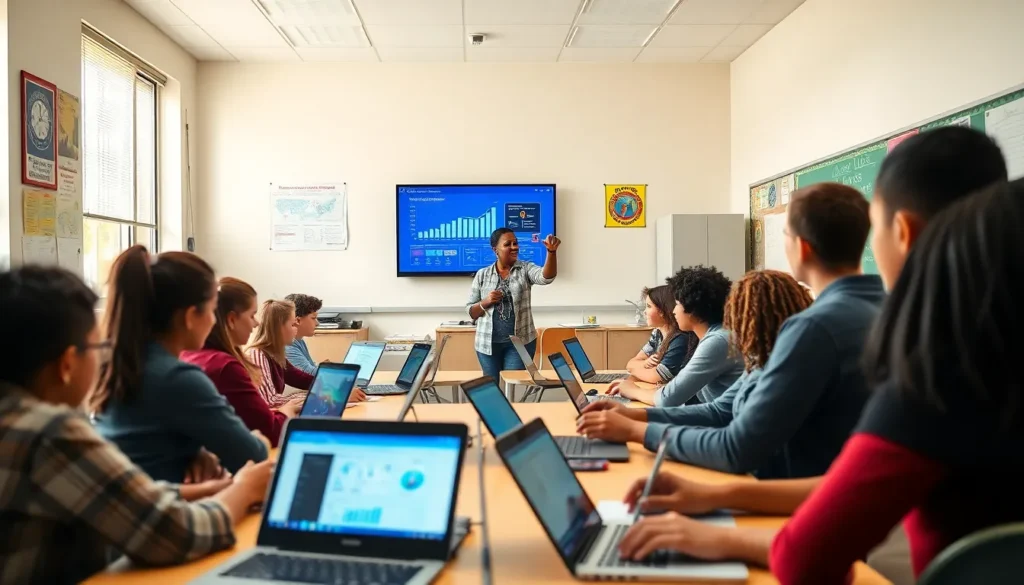Distance education has transformed the way people learn, breaking down geographical barriers and making education accessible to all. With the rise of technology, students can now engage in courses from the comfort of their homes, connecting with instructors and peers worldwide. This modern approach to learning offers flexibility and convenience, catering to diverse lifestyles and commitments.
As traditional classrooms evolve, distance education presents unique opportunities and challenges. It’s not just about online lectures; it encompasses a variety of learning methods, including interactive platforms and multimedia resources. Understanding the dynamics of distance education is essential for both students and educators seeking to navigate this rapidly changing landscape.
Table of Contents
ToggleOverview of Distance Education
Distance education refers to the method of learning where instruction occurs remotely, allowing students to engage in educational activities from various locations. This format leverages digital tools and resources, enabling flexible learning experiences. Students access course materials, often through online platforms, which include videos, audio lectures, and interactive forums.
Technology plays a critical role in distance education. Learning management systems (LMS) provide an organized environment for both instructors and learners. These systems support course delivery, grading, and communication, fostering essential interactions among participants. Educators utilize multimedia resources to enhance understanding and maintain engagement.
Flexibility characterizes distance education, allowing individuals to balance studies with work or personal commitments. Asynchronous courses permit learners to access content anytime, promoting self-paced learning. Synchronous courses, on the other hand, offer real-time interactions, maintaining a classroom-like experience.
Distance education presents unique opportunities and challenges. Opportunities include a wider selection of courses, catering to diverse interests and career goals. Challenges encompass issues related to self-discipline, motivation, and the limited social interaction compared to traditional classrooms. Recognizing these factors is vital for maximizing the benefits of distance education while addressing potential obstacles.
Benefits of Distance Education


Distance education offers numerous advantages that enhance the learning experience. It emphasizes flexibility and accessibility, making it suitable for a wide range of learners.
Flexibility and Accessibility
Flexibility characterizes distance education, allowing students to tailor their study schedules around personal commitments. Students can engage with course materials at their convenience, accommodating work, family, or other responsibilities. Accessibility also improves as learners can access education regardless of geographical location, breaking down traditional barriers. Online platforms facilitate participation from remote areas, enabling individuals who may have limited mobility or resources to pursue their educational goals.
Diverse Learning Resources
Diverse learning resources enrich the experience in distance education. Online courses often include a variety of materials, such as video lectures, interactive quizzes, and discussion forums, which cater to different learning styles. Students can access a wealth of digital content and educational tools that traditional classrooms may not provide. This abundance of resources encourages active engagement and supports deeper understanding of the subject matter, enhancing the overall educational experience.
Challenges of Distance Education
Distance education presents several challenges that students and educators must navigate to optimize learning outcomes. Key issues include a lack of face-to-face interaction and technology barriers.
Lack of Face-to-Face Interaction
Lack of face-to-face interaction hampers the development of personal connections within educational environments. Students miss opportunities for spontaneous discussions and immediate feedback that traditional classrooms provide. Limited social engagement can lead to feelings of isolation, affecting motivation and perseverance. Students may struggle to build rapport with instructors and peers, reducing collaborative learning experiences. Moreover, this absence of personal interaction may hinder the formation of a supportive community vital for academic success.
Technology Barriers
Technology barriers significantly impact accessibility and engagement in distance education. Students require stable internet connections and compatible devices to participate fully in online courses. Inadequate access to technology can result in unequal learning opportunities. Furthermore, not all students possess the necessary technical skills to navigate online platforms and learning management systems effectively. These challenges can contribute to frustration, leading to disengagement from coursework. Training and support become essential to help students overcome these hurdles and maximize their educational experiences.
Effective Strategies for Distance Education
Distance education thrives on effective strategies that enhance learning experiences. Engaging course design and promoting student interaction play vital roles in achieving educational success.
Engaging Course Design
Engaging course design captures student interest and maximizes learning outcomes. Courses should incorporate diverse multimedia resources, including videos, infographics, and podcasts, to cater to various learning preferences. Structured content, such as modules and assignments, provides a clear learning path for students.
Active learning elements, like quizzes and interactive case studies, facilitate participation and knowledge retention. Regular assessments and feedback encourage students to track their progress and adjust study habits accordingly. Incorporating real-world applications fosters relevance and encourages deeper understanding of the subject matter, making learning more impactful.
Promoting Student Interaction
Promoting student interaction enhances collaboration and builds a supportive learning community. Discussion forums and group projects encourage peer engagement and create opportunities for idea exchange. Video conferencing tools allow students to connect face-to-face, mimicking traditional classroom environments and sustaining social interaction.
Instructors should facilitate discussions by posing thought-provoking questions and responding to student contributions, creating an inclusive atmosphere. Encouraging mentorship and study groups among peers fosters accountability and support, helping students navigate the challenges of distance education effectively.
Future Trends in Distance Education
Distance education continues to evolve, reflecting technological advancements and shifting learner preferences. Several key trends are shaping its future landscape.
Increased Use of Artificial Intelligence
Artificial Intelligence (AI) integration enhances personalized learning experiences. AI can analyze student performance data to tailor content and suggest resources. For example, adaptive learning platforms adjust difficulty levels based on individual progress, ensuring students engage with material that meets their needs.
Rise of Virtual and Augmented Reality
Virtual Reality (VR) and Augmented Reality (AR) technologies are transforming educational environments. These immersive experiences allow students to engage in simulations and interactive learning exercises, bridging the gap between theoretical knowledge and practical application. For instance, medical students can practice surgical techniques in a controlled, virtual setting.
Growth of Mobile Learning
Mobile learning is increasingly popular as learners rely on mobile devices for access to education. Course materials optimized for smartphones and tablets enable students to study anytime, anywhere. Institutions can also develop apps that foster communication and provide resources, enhancing engagement.
Focus on Microlearning
Microlearning delivers content in short, bite-sized modules catering to busy schedules and varying attention spans. This format promotes knowledge retention and allows for quick, targeted learning sessions. For example, professionals can complete a brief course on new software features during a lunch break.
Expansion of Global Learning Communities
Distance education fosters global collaboration among students from diverse backgrounds. Online forums and projects encourage shared perspectives and cross-cultural exchanges. This global network enriches learning experiences and prepares students for an interconnected world.
Emphasis on Lifelong Learning
The demand for continuous skill development drives the emphasis on lifelong learning. Distance education platforms are adapting by offering a range of courses and certifications that cater to career advancements and personal interests. Flexible scheduling supports ongoing education, allowing learners to balance work and study effectively.
Development of Enhanced Learning Analytics
Learning analytics tools are crucial for measuring student engagement and performance. These analytics provide instructors with insights to refine course designs and improve student outcomes. For instance, analytics can reveal patterns in participation or assignment submission, enabling timely interventions.
Increased Collaboration with Industry
Partnerships between educational institutions and industry players are emerging. These collaborations ensure that courses align with current job market demands and equip students with relevant skills. For example, online programs may include internships or projects that give learners real-world experience.
Focus on Mental Health and Well-being
Recognizing the importance of mental health, distance education programs are incorporating support resources. Institutions may offer counseling services, workshops, or wellness activities to promote student resilience and well-being. This holistic approach fosters a supportive learning environment essential for student success.
These trends reflect the ongoing transformation in distance education, highlighting its adaptability and potential to meet the evolving needs of learners.
Distance education represents a significant shift in how learning is approached today. Its ability to offer flexibility and accessibility empowers students to pursue their educational goals on their terms. While challenges like isolation and technology barriers exist, the benefits of this modern learning format are undeniable.
As advancements in technology continue to shape distance education, the potential for personalized and engaging learning experiences expands. By embracing innovative strategies and fostering supportive communities, both educators and students can navigate this evolving landscape effectively. The future of education is bright with distance learning at the forefront, making quality education more attainable than ever before.









